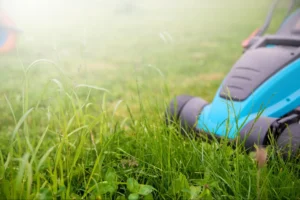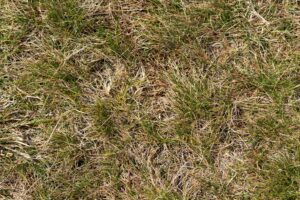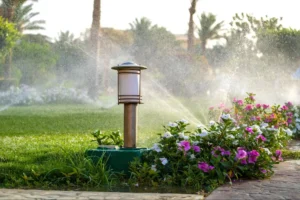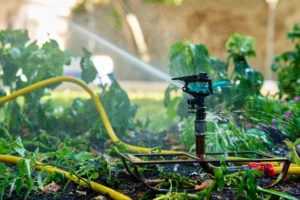In the heart of Georgia, maintaining a lush, green lawn can feel like a challenging job, especially with the heat and humidity that characterize our summers. If you’re aiming for a beautiful yard that thrives during the warm season, understanding how to properly fertilize your grass is essential. At Weed Pro, we’ve made it our mission to help Georgia homeowners master proper fertilization techniques that keep their lawns healthy, vibrant, and resilient all year long. In this guide, we’ll explore the best practices for fertilizing warm-season grasses in Georgia to ensure your lawn remains strong and beautiful throughout the changing seasons.
Warm-season grasses, such as Bermuda, Zoysia, Centipede, and St. Augustine, are the stars of Georgia lawns. Bermuda grass, in particular, is a popular, heat- and drought-tolerant warm-season turf that is ideal for high-traffic areas such as lawns, sports fields, and golf courses. It is known for its durability, ability to recover from wear, and relatively low maintenance requirements, making it especially suitable for the Southeast U.S. These grasses flourish during the hot summer months and enter dormancy in cooler weather, making them well-suited for our climate. By fostering their growth during the active months, you can achieve a lush, resilient turf that withstands the challenges of heat and humidity. Laying sod is an effective way to create an instant lawn, especially for new construction or when you need to quickly repair bare spots in your yard.
Introduction to Warm Season Grasses
As we’ve said warm season grasses are the backbone of a thriving lawn in Georgia’s hot and humid climate. Grasses, such as Bermudagrass, Zoysia grass, and Bahiagrass, are specially adapted to flourish during the warm season then enter a period of dormancy during the winter months (unlike cool season grasses). To achieve a healthy warm season lawn, it’s important to focus on consistent lawn care practices—this includes regular mowing, proper watering, and timely fertilization. Choosing high-quality grass seed, like those from trusted brands such as Pennington Seed or Lake Valley Seed, can make a significant difference in establishing a dense, resilient turf. By understanding the unique needs of these season grasses, homeowners can enjoy a beautiful, thriving lawn that stands up to Georgia’s challenging weather.
Common Grass Types in Georgia
- Bermuda: Fast-growing and drought-resistant, ideal for full sun.
- Zoysia: Tolerates heat and drought, slow to establish but forms a dense turf.
- Centipede: Low-maintenance and well-adapted to Georgia’s soil but grows slower.
- St. Augustine: Thrives in shade and is well-suited for coastal areas.
Georgia offers a wide variety of grass species, each with unique ecological roles, growth characteristics, and management needs, making it important to select the right species for your specific environment and intended use.
Importance of Soil Testing
Before diving into fertilization, it’s crucial to test your soil. A soil test reveals pH levels and nutrient deficiencies, allowing you to tailor your fertilization approach effectively. Soil pH directly affects grass growth and influences fertilizer recommendations, as certain grasses are sensitive to soil pH—centipede grass, for example, does not tolerate high alkalinity. Over-fertilizing is not only wasteful but can also harm your lawn. By understanding your soil’s needs, you can make informed decisions that promote healthy grass growth.
Optimal Fertilization Schedule in Georgia
Timing is everything when fertilizing warm-season grasses. To get the best results, follow this optimal fertilization schedule:
- Late April to Early May: Start fertilizing once the grass has fully greened up. This period coincides with spring green up, which is the optimal time to begin fertilizing as the grass emerges from dormancy.
- Bermuda and Zoysia: Feed every 6 to 8 weeks until mid-August for robust growth.
- Centipede: Fertilize twice, once after green-up and again in mid-summer.
- Avoid Fall Fertilization: This can lead to winter damage as grass enters dormancy.
Late spring and early summer are also ideal times for other lawn care activities such as aeration, dethatching, and overseeding, as the grass is actively growing and can recover quickly.
Choosing the Right Fertilizer
Selecting the right fertilizer is crucial for your grass type. A balanced fertilizer with an N-P-K ratio is ideal. For instance, an 8-18-22 or a 15-0-15 mix can provide moderate nitrogen for strong growth. Always refer to your soil test results to determine the best nutrient ratios tailored specifically for your lawn.
Best Practices for Applying Fertilizer
When it comes to applying fertilizer, there are several best practices to keep in mind:
- Fertilize after the grass has fully greened up and is actively growing to maximize nutrient uptake and recovery.
- Always follow label instructions for applying the correct spread rate and timing.
Proper Application Techniques
Using a spreader ensures even distribution across your lawn. Over-application can lead to burned grass, so stick to recommended rates.
Watering and Aeration After Application
After applying fertilizer, immediate watering is necessary to activate the nutrients and help them penetrate the soil. A well-maintained sprinkler system ensures efficient and even watering after fertilization; regular checks, winterization, and integration with rain sensors help prevent overwatering and maintain consistent turf health.
If your lawn is compacted, consider performing lawn aeration before application. Lawn aeration is an essential procedure that loosens compacted soil by creating holes, improving soil health and nutrient absorption, especially for lawns with heavy foot traffic or clay soil. This helps improve nutrient absorption and root growth, leading to a healthier lawn.
Controlling Weeds and Pests
Effective weed control and pest management are essential for maintaining a healthy warm season lawn. Weeds not only compete with your grass for vital resources like water and nutrients, but they can also disrupt the uniform look of your lawn. To prevent weed seeds from taking hold, apply pre emergent herbicides in early spring before weeds have a chance to germinate. For existing weeds, post emergent herbicides can help keep your lawn clear throughout the growing season. Regular mowing with sharpen mower blades helps maintain the right grass height and discourages weed growth, while also reducing thatch buildup. Maintaining proper soil moisture is another key factor in weed prevention, as healthy grass is better able to outcompete unwanted plants. For pest control, use selective herbicides and follow integrated pest management (IPM) practices to target harmful insects while protecting beneficial ones. By staying proactive with weed and pest control, you’ll support a strong, vibrant warm season lawn all year long.
Cool Season Grasses Comparison
While warm season grasses are well suited for Georgia’s climate, it’s helpful to understand how they differ from cool season grasses. Cool season grasses, such as Kentucky bluegrass and perennial ryegrass, thrive in cooler temperatures—typically between 40°F and 75°F—and are commonly used in northern regions. These grass types struggle in the heat and drought conditions of the Deep South, where warm season grasses like Bermuda and Zoysia excel. When selecting the best grass type for your lawn, consider your local climate, soil type, and how you plan to use your lawn. Warm season grasses are ideal for areas with hot summers and mild winters, while cool season grasses are better for regions with long, cool growing seasons. Making the right choice ensures your lawn remains healthy and attractive throughout the year.
Regional Considerations
Choosing the right warm season grass for your lawn depends heavily on your region’s climate and soil conditions. For example, Bermudagrass is particularly well suited for the Deep South, thriving in full sun and high temperatures. Zoysia grass, on the other hand, offers excellent drought tolerance and can handle cooler temperatures, making it a great option for transition zones where weather patterns fluctuate. Centipede grass is a favorite for lawns with acidic soil, as it requires less maintenance and adapts well to Georgia’s unique soil structure. By understanding the specific needs of your area and selecting a grass type that matches your local environment, you’ll set the stage for a thriving lawn that can withstand regional challenges and look its best year-round.
Common Mistakes to Avoid
Avoiding common mistakes can significantly improve the health of your lawn. Ongoing lawn maintenance is essential for an existing lawn to avoid common pitfalls and ensure long-term health:
- Fertilizing Too Early: Ensure your grass is out of dormancy first.
- Excessive Nitrogen Application in Late Summer: This can create weak grass that is susceptible to winter damage.
- Neglecting Soil Tests: Always test to match fertilizer choices with the specific needs of your grass type.
Successfully fertilizing warm-season grasses in Georgia requires knowledge, planning, and attention to detail. By understanding your grass types, soil needs, and optimal scheduling, you can cultivate a vibrant existing lawn that thrives all year. Remember, at Weed Pro, we’re here to help you achieve the lawn of your dreams with tailored treatment plans designed specifically for Georgia’s unique environment.
Conclusion
In conclusion, warm season grasses are the key to a beautiful, resilient lawn in Georgia’s challenging climate. By focusing on regular lawn care—including proper mowing, watering, and fertilization—you can cultivate a thriving lawn that stands up to heat stress and drought. Effective weed control and pest management are also crucial for protecting your investment and ensuring your lawn remains lush and healthy. Selecting the right grass type for your region, following a consistent lawn care calendar, and using premium grass seed products will help you achieve the best results. Always rely on soil test recommendations to guide your fertilization and maintenance practices. With the right approach, your warm season lawn will remain vibrant and strong, providing lasting beauty and enjoyment throughout the year.
Frequently Asked Questions about Fertilizing Warm Season Grasses in Georgia
What are the best times to fertilize warm season grasses in Georgia?
The optimal times to fertilize warm season grasses in Georgia are from late April to early May, followed by every 6 to 8 weeks for Bermuda and Zoysia until mid-August. Centipede should be fertilized twice during the growing season.
How do I choose the right fertilizer for my warm season grass?
Select a balanced fertilizer with an appropriate N-P-K ratio based on soil test results. Options like 8-18-22 or 15-0-15 are suitable for many warm season grasses in Georgia.
Why is soil testing important before fertilizing my lawn?
Soil testing is crucial as it reveals pH levels and nutrient deficiencies, allowing you to customize your fertilization strategy. This ensures effective growth and prevents harmful over-fertilization.
Can I fertilize my grass in the fall?
No, you should avoid fall fertilization as it can lead to winter damage when the grass enters dormancy. Focus on spring and summer for effective fertilization.
What common mistakes should I avoid when fertilizing my lawn?
Common mistakes include fertilizing too early, over-application of nitrogen in late summer, and neglecting soil tests. These can weaken your grass and lead to poor lawn health.
How do I apply fertilizer correctly for warm season grasses?
Use a spreader for even distribution and always follow label instructions for correct application rates. Watering immediately after application helps activate nutrients for better absorption.







